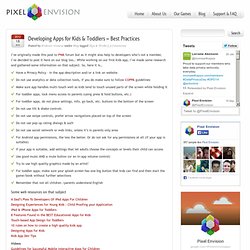

Sesame best practices guide for children's app development. Touch screen technology is revolutionizing interactive digital experiences for children. No longer do our little ones need to wait to learn to navigate a mouse or press keyboard keys in order to access a host of interactive content designed for them. Instead, we see toddlers and preschoolers confidently navigating their parents’ iPhones, iPads, and other touch screen devices with astonishing agility and purpose. The explosion of apps for young children is not surprising; there is high demand and high appeal. Best Practices Document 11-26-12.pdf (application/pdf Object) Developing Apps for Kids & Toddlers – Best Practices.
I’ve originally made this post to PWA forum but as it might also help to developers who’s not a member, I’ve decided to post it here on our blog too… While working on our first kids app, I’ve made some research and gathered some information on that subject.

So, here it is… Have a Privacy Policy – in the app description and/or a link on websiteDo not use analytics or data collection tools, if you do make sure to follow COPPA guidelinesMake sure app handles multi-touch well as kids tend to touch unused parts of the screen while holding itFor toddler apps, lock menu access to parents (using press & hold buttons, etc.)For toddler apps, do not place settings, info, go back, etc. buttons to the bottom of the screenDo not use tilt & shake controlsDo not use swipe controls, prefer arrow navigations placed on top of the screenDo not use pop-up rating dialogs & suchDo not use social network or web links, unless it’s in parents only areaFor Android app permissions, the less the better. Kids and mobile technology trends. As parents become less hesitant about handing over their smartphones and tablets to their kids, developers are taking advantage of the trend and designing more apps targeted specifically to children.

According to an infographic put together by EverydayFamily.com, 77 percent of parents think tablets help children's learning and creativity. And 70 percent of children under the age of 12 have used a mobile device or tablet. Most children use game apps, but more than half also use tablets for educational purposes as well. Schools have also realized this trend and more than 600 U.S. school districts reported using iPad programs to replace textbooks in 2011.